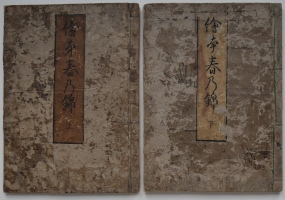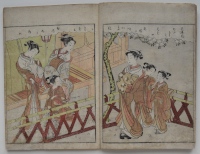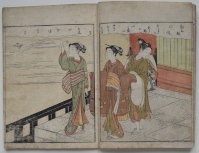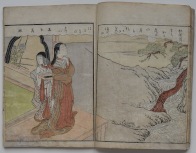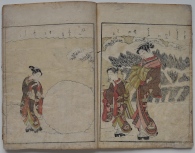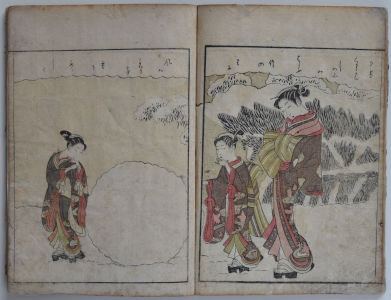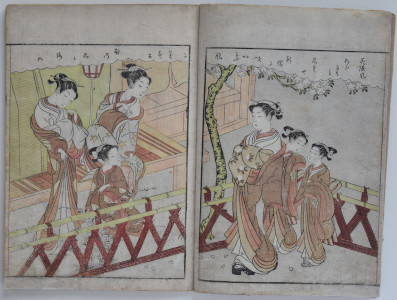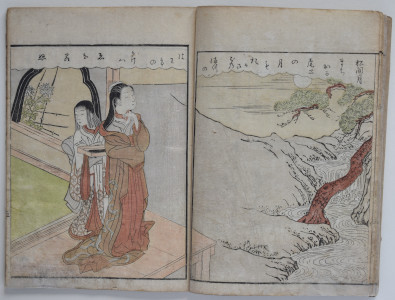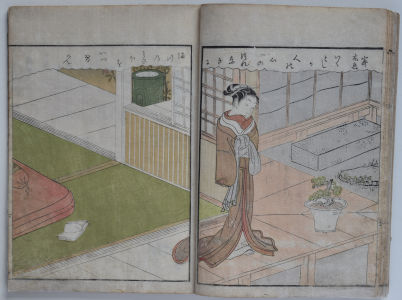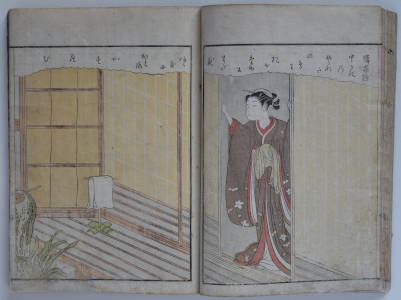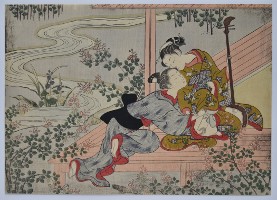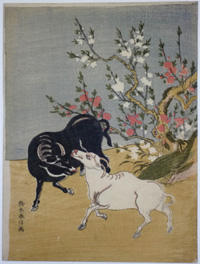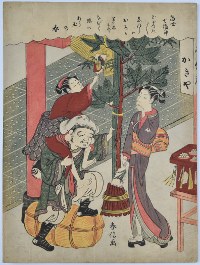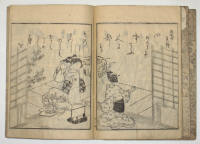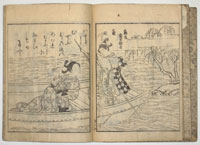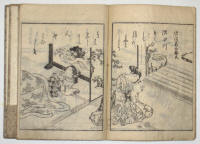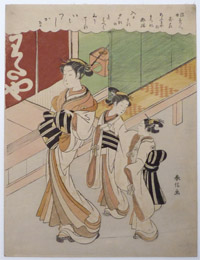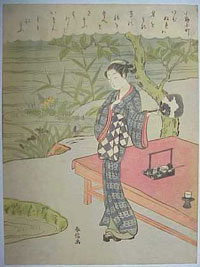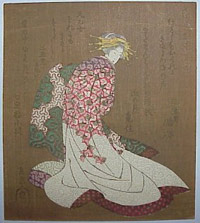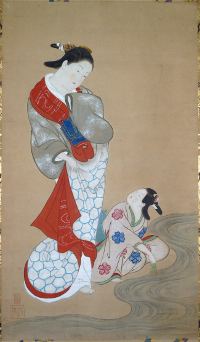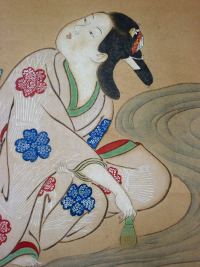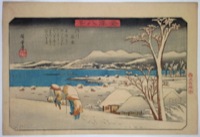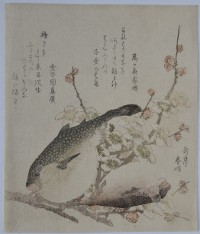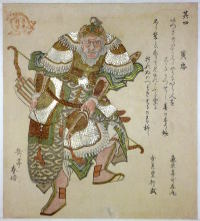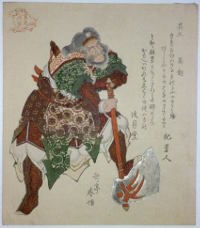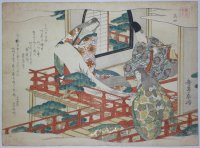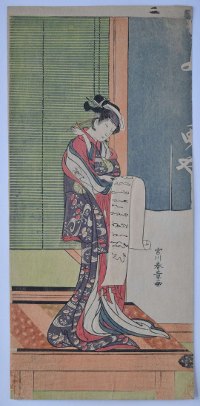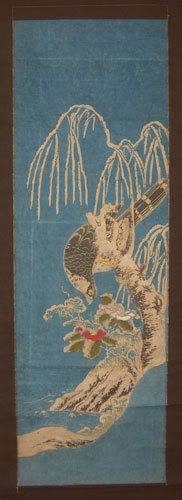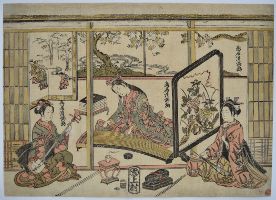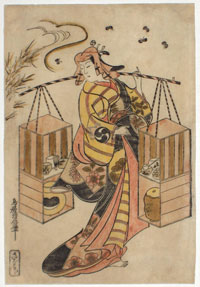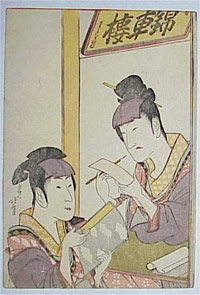Suzuki HARUNOBU (1724-1770)
Click here to view image full size.
Two volumes complete: Ehon haru no nishiki, “Picture Book: The Brocades of Spring.” Vol. 1: 1 page preface dated Kanoto U (1770); single page and 8 double page colour prints. Vol. 2: 1 single page and 8 double page colour prints. 1 page colophon with date, publisher, block-cutter and artist as Suzuki Harunobu with his seal. 2 pages publisher’s announcements. Published by Yamazaki Kimbe, Edo. This is the first edition, Meiwa 8 (1771). Other copies are in the MFA, Boston, acc. no. 1997.477.1-2 and the Philadelphia Museum of Art, acc. no. 1970-46-1. Provenance: Ex collections H.M.Kaempfer and Hayashi (their seals on the first page of each volume). Original covers and title slips. Covers worn. Some soil and edge restoration.
Very good impressions with generally very good colour. Rare in the first edition.
Status: Available
Suzuki HARUNOBU (1724-1770)
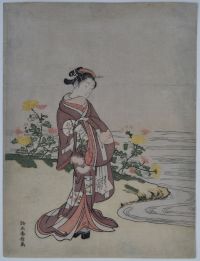
Click here to view image full size.
A beauty standing beside a stream where wild chrysanthemums grow. A mitate-e (parody) of Kikujido, the Chrysanthemum Boy, who was the favourite of the Chinese Emperor Mu (c. 950 B.C.). However, because of court jealousy, he was banished but had his exile eased by the Emperor who gifted him the ability to read sacred Buddhist texts. He became an immortal, spending his days surrounded by chrysanthemums and inscribing words of peace on the flowers’ petals. This is the second state: The first (private edition) is a calendar print with a signature (of an amateur) Kinga Ko and seal and has the year and its cyclical signs for 1766. These Harunobu calendar prints, printed in small numbers, were commissioned by wealthy individuals between c. 1764 and 1766 and so popular that they were published commercially. Rare.
Very good impression and colour Very minor edge soil, otherwise very good condition. Signed Suzuki Harunobu ga.
Status: Available
Suzuki HARUNOBU (1724-1770)

Click here to view image full size.
A pillar print showing a young dandy holding an Odawara lantern on entering a Shinto shrine. One leg of the Torii is in the background behind a hinoki tree. Another impression is illustrated in The Japanese Pillar Print, Hashira-e, Jacob Pins, Robert G. Sawers publishing, 1982, 184a, p. 118 which also shows a variant impression with a night sky, 184b.
Very good impression. Good colour for a pillar print: This format is notorious for fading and browning. Very good condition. Signed Suzuki Harunobu ga.
Status: Sold
Suzuki HARUNOBU (c 1725-1770)
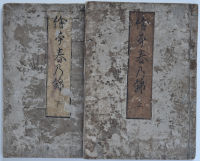
Click here to view image full size.
Two volumes complete: Ehon haru no nishiki, “Picture Book: The Brocades of Spring.” Vol. 1: 1 page preface dated Kanoto U (1770); single page and 8 double page colour prints. Vol. 2: 1 single page and 8 double page colour prints. 1 page colophon with date, publisher, block-cutter and artist as Suzuki Harunobu with his seal. 2 pages publisher’s announcements. Published by Yamazaki Kimbe, Edo. This is the first edition, Meiwa 8 (1771). Other copies are in the MFA, Boston, acc. no 1997.477.1-2 and Philadelphia Museum of Art, acc. no. 1970-46-1. Provenance: Ex collections H.M.Kaempfer and Hayashi (their seals on the first page of each volume). Original covers and title slips. Covers worn. Some soil and edge restoration. Very good impressions with generally very good colour. Rare in the first edition.
Status: Sold
Suzuki HARUNOBU (1724-1770)
Click here to view image full size.
A wonderful chuban shunga print showing a young suitor leaning across an engawa and interrupting a beauty playing a shamisen by partially lifting her robe. They are surrounded by flowering bushes and a meandering stream. A rare design I cannot, at the moment, locate being illustrated. Published c. late 1760s.
Very fine impression on thick hosho. Extremely fine colour. Slight oxidation, otherwise fine condition.
Status: Sold
Suzuki HARUNOBU (1724-1770)

Click here to view image full size.
A chuban shunga print showing the occupant of a kago in flagrante with one of the porters, having seized the opportunity of a stop on the journey. Published late 1760s. Rare.
Very fine impression on thick hosho: The outlines raised in certain areas. Fine colour and condition.
Status: Sold
Suzuki HARUNOBU (1724-1770)

Click here to view image full size.
A couple in flagrante on an open engawa which has a large bowl of goldfish. There were many attempts by the Tokugawa Shogunate (1603-1868) to suppress shunga with edicts issued in 1661, 1722 and the 1790s. None of these were particularly effective and production usually resumed with most Ukiyo-e artists producing shunga prints, books or paintings. Published c. 1768. Unsigned as often with these shunga prints.
Superb impression. Fine, unfaded colour. Fine condition.
Status: Sold
Suzuki HARUNOBU (1724-1770)

Click here to view image full size.
A chuban shunga print showing a fisherman taking advantage of a young girl on a boat on the Sumida River. The couple are hidden behind a four-armed scoop-net called a yotsude-ami which was used to catch whitebait in the spring. The British Museum copy (OA+,O.125) gives the location as most probably being at Mitsumata, between Eitai and Shin’o bridges, based on what looks like Lord Tayasu’s residence in the background. Another impression is illustrated in Shunga, Marco Fagioli, Octavo, 1997, no. 23, p.45. Published late 1760s. Rare.
Very good impression. Some slight fading, otherwise good condition.
Status: Sold
Suzuki HARUNOBU (c 1725–1770)
Click here to view image full size.
A chuban print of a pair of oxen. One of the Junishi, Twelve Zodiacal Signs ( this being Ushi ). Complemented here by a red and white plum tree. People born in the Year of the Ox are known to be difficult but, once committed, they are loyal for life. And the plum tree symbolizes conjugal loyalty. Exceptionally rare: One other impression is illustrated in Yoshida, Harunobu zenshu, p. 112. Indeed, Harunobu designed very few kachoga, unlike Koryusai who made many a few years later. This could have been intended as one of a set of twelve prints, but the likelihood is that it is a single design. Published c 1767.
Fine impression with the outlines of the oxen heavily gauffraged. Exceptional condition: The background blue is from the dayflower ( Commelina communis L. ). One of the most fugitive pigments, here completely intact. The petals were collected at dawn, squeezed, and applied to paper which was used as a carrier. Very fine colour and condition. Signed Suzuki Harunobu ga.
Status: Sold
Suzuki HARUNOBU (1724-1770)
Click here to view image full size.
A fine chuban from a series parodying the Seven Gods of Good Fortune, this being Daikoku, the god of wealth, seen here attempting to stand on one of his straw bales of rice. The famous waitress Kasamori O-sen (1751-1827) stands holding a battledore on New Year’s Day while her companion balances on Daikoku’s shoulders attempting to retrieve the shuttlecock caught in the kado-matsu decorations using her own battledore. The lantern on the right reads Kagi-ya, which was a tea-house located by the Kasamori Inari Shrine in Yanaka, north of Edo, which was owned by O-sen’s father and where she was the waitress. Considered to be one of “The Three Beauties” of her time. (Given the date of the print, she must have been around 18 when shown here.) The Torii gate is seen on the left. The poem above speaks of a New Year’s fresh gem [O-Sen] and how the trees and grasses bend to her. Published c. 1769.
Fine impression: As with many Harunobu, the lines are in relief because of the thick hosho. Exceptional colour: Even the vegetable blue used for the paving stones leading to the temple have not turned except at the extreme left and right. This was a colour used frequently by Harunobu to depict water but is almost always faded to a puce colour. Minimal soil, otherwise a fine example from this period. Signed Harunobu ga.
Status: Sold
Suzuki HARUNOBU (1724-1770)
Click here to view image full size.
3 volume complete : Ehon yachiyogusa, “The Plant of Eight Thousand Ages”. Sumi images illustrating old poems with the Sumida River as a central theme. Published Meiwa 5, 1768 by Yamazaki Kinbei.
Original covers but later title slips. One page with sumi marks, otherwise good impressions and condition.
Status: Sold
Suzuki HARUNOBU (1725-1770)
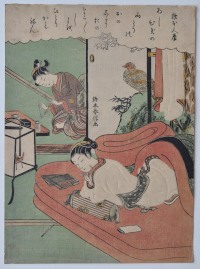
Click here to view image full size.
A chuban print from an untitled series showing a courtesan lying under a futon waiting for her kamuro to prepare her pipe in the adjoining room. A fusuma partially separates the two rooms and has a painting of a mountain pheasant on a craggy rock (alluded to in the poem above which is by Kakinomoto no Hitomaro, one of the famous Thirty-six Immortal Poets). This poem, which is also interpreted by Hokusai in his set One Hundred Poems Explained by the Nurse, is complex and speaks of long nights dragging by like a mountain trail or a pheasant’s tail. Published c 1768. A particularly rare Harunobu: Another impression is in the BM: A_1937-0710-0-18.
Fine impression with beautiful blind-printing delineating her body. The material hanging behind her is also gauffraged. Very good colour. Minor soil and signs of mounting au verso, otherwise very good condition. Signed on the fusuma Suzuki Harunobu ga.
Status: Sold
Suzuki HARUNOBU (1724-1770)
Click here to view image full size.
A chuban showing the courtesan Matsukaze of the Ogi-ya House from a set of prints: Ukiyo kika, “Strange Flowers of the Floating World.” Shows the courtesan parading outside a Yoshiwara house with her two kamuro. One of the most influential ukiyo-e artists taking full advantage of polychrome printing in 1765 and publishing a large number of exquisite prints, often with innovative pigments and on thick hosho. Published c late 1760s. Another impression in Yoshida, Harunobu zenshu, p. 128.
Fine impression. Slight fading otherwise very good condition. Signed Harunobu ga.
Status: Sold
Suzuki HARUNOBU (1724-1770)
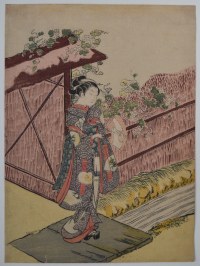
Click here to view image full size.
The left sheet of a rare diptych which was originally produced as an egoyomi (picture calendar) in 1766. A mitate (parody) of Chapter 4, Yugao, from the Genji Monogatari, “Tale of Genji.” This chapter relates how a mysterious beauty living in a mansion covered in vines with flowering yugao blossom (shown here covering the fence) enraptures Genji and they consummate their passion in a remote villa. However, one of Genji’s former lovers discovers the tryst and takes the life of “Yugao.” The right sheet shows a fashionably dressed young wakashu and a boy holding a miniature ox cart cricket cage. Other impressions in: Margaret O. Gentles, The Clarence Buckingham Collection, volume II, AIC, 1965, p. 26, no. 44; Tokyo National Museum, acc. no. A-10569_1274 (diptych) (inv. No. 10-5006); David Waterhouse, The Harunobu Decade, Museum of Fine Arts, Boston, 2013, vol. 1, pp. 88-89, cat. No. 100, acc. nos. 54.348-9 (diptych) and 21.4969 (left sheet); and Ukiyo-e Shuka, vol. 8, 1980, listed p. 116, no. 114. Rare.
Fine impression with the woodgrain showing strongly in the background as though it were blind-printed. Very good colour and condition.
Status: Sold
Suzuki HARUNOBU (1724-1770)
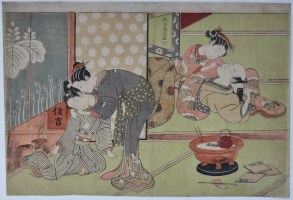
Click here to view image full size.
Two couples in a brothel. The young man near the entrance seems in need of a lot of encouragement. The name written on the left of the entrance is Sumiyoshi. A chuban yokoe design published c 1769-70. Another impression is in ROM, 926.18.121.
Very good impression and colour. Minimal soil, otherwise good condition. Signed Suzuki Harunobu ga on the rear screen.
Status: Sold
Suzuki HARUNOBU (1724-1778)
Click here to view image full size.
A chuban print of a young girl beside a stream. A poem above, by Ono no Komachi, compares her thoughts to a floating reed. One of a series based on “The Thirty-six Poets”. Another impression illustrated in the Philadelphia Musuem of Art catalogue Suzuki Harunobu, 1970, p.141, no.79. Published c.1767/8.
Superb impression with the girl’s outline and garment folds in heavy relief. Fine colour with only the water slightly down. Signed Harunobu ga.
Status: Sold
Suzuki HARUNOBU (1724-1770)
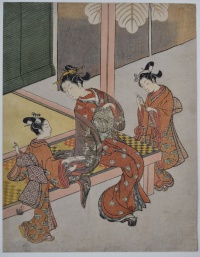
Click here to view image full size.
An unsigned chuban showing a seated courtesan with her two kamuro. One brings a letter while the other cleans her mistress’s tobacco pipe. Behind is a large kiri-mon on a noren. Published c. 1766-67. Other impressions in the Tokyo National Museum, Honolulu Academy of Arts and The Metropolitan Museum of Art. Rare.
Fine impression. Particularly well preserved colours: Most Harunobu prints sold are faded to some degree. Slight “turning” of the colour on the top of the noren and small smudge bottom left, otherwise very good condition.
Status: Available
Suzuki HARUNOBU (1724-1770)

Click here to view image full size.
A pillar print showing a beauty after a bath walking past a pot of morning glory. Published c. 1768. The morning glory is a precursor of hot summer. Some 40 or 50 years later there was a craze for these plants almost akin to Dutch tulip fever. Other (faded) impressions are in MFA, Boston, Spaulding Collection, nr. 21.4552; Honolulu Museum of Art, nr. 06108; and illustrated in Waterhouse, The Harunobu Decade, 20013, nr. 545. Harunobu produced some of the most sublime Ukiyo-e images and he and his publishers were at the forefront of experimentation in the 1760s using multiple blocks, new pigments and combing pigments to create new hues that were not see again in Ukiyo-e. Unfortunately, the pigments – most often of vegetable origin – were very susceptible to fading and most Harunobu prints are ghosts of their former selves. Harunobu was a master of this hashira-e format: Jacob Pins found 111 to illustrate in The Japanese Pillar Print, 1982. Rare.
Fine impression. Exceptionally good colour. Minor soil but in very good condition for a print in this format and of this period. (These prints were hung in alcoves or on pillars and they consequently often come browned or faded as well as getting creased by being rolled.) Signed Harunobu ga.
Status: Sold
Harunobu GAKUTEI (c.1786 – 1868)
Click here to view image full size.
A sumptuously clothed beauty designed for the Shippo Club. The surimono is unusual in having a caramel-coloured background.
Fine impression, colour and condition. Signed Gakutei with seal Shima.
Status: Sold
Suzuki HARUNOBU (1725-1770)
Click here to view image full size.
A beautiful composition of a courtesan emerging from a mosquito net. Published c 1760’s. Ex collection Hayashi. Rare: not in Pins or Yoshida.
Very good impression and colour. Very slight soil but in very good condition for a pillar print of this period. Signed Harunobu ga..
Status: Sold
Yamamoto FUJINOBU (Active 1750-1770)

Click here to view image full size.
An original painting, full colour on paper, image size 32.25 x 7 in; 82 x 18 cms. Shows a parading courtesan with her kamuro. A painter and print artist whose prints were always published by Yamamoto Fusanobu giving rise to the theory that Fujinobu was a pseudonym of the publisher. Much influenced by Harunobu. His prints are extremely rare. Slight creasing, otherwise good condition. Signed Fujinobu ga with indistinct seal.
Status: Available

Click here to view image full size.
Attributed to Suzuki HARUSHIGE (Shiba KOKAN 1747-1818)
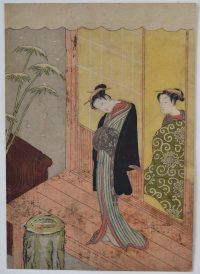
Click here to view image full size.
A winter scene with a young courtesan on an engawa gazing at an upturned ladle resting in a water basin formed from a hollow tree trunk. Behind her a young beauty peers out through the shoji. The scene calls to mind the Bell of Damnation (Muken no kane) act in the play Hiragana Seisuiki where Umegae strikes the water basin with a ladle to produce gold coins. Harushige was the ukiyo-e go of Shiba Kokan, the first artist to try copper plate engraving and who studied oil painting and etching from books he saw in Nagasaki. For a time a pupil of Harunobu whose style his prints resemble. Extremely rare: I cannot, at the moment, locate another impression. Published c early 1770s.
Fine impression. Extremely good colour, the orange pigment partly oxidised. Possibly slightly trimmed left and bottom, otherwise very good condition.
Status: Available
Suzuki HARUTSUGI (HARUJI) (Active 1760-1770)
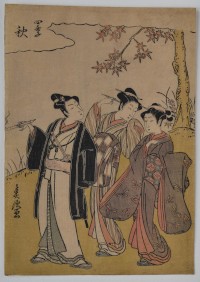
Click here to view image full size.
A large koban print, 8.75 x 6 in; 22.25 x 15.25 cms, showing a samurai with two attendants. Aki, “Autumn” from a set of the four seasons, Shiki. A rare artist and most likely a follower of Harunobu. Produced a number of pillar prints. Provenance: Ex Javal, sold 3/3/1926, lot 50.
Very good impression, colour and condition. Signed Harutsugi ga.
Status: Available
Nishikawa Sukenobu, 1671-1750
Given names: Bunkado; Bunkadô; Fujiwara; Jitokusai; Jitokusō; Magoemon; “Uji” Nishikawa; Nishikawa Nishikawa Sukebê /Sukebê; Nishikawa Sukenobu; Saiō; Sukenobu; Uemon; Ukyô; Ukyō; Yûsuke
Sukenobu was “The most accomplished and influential Ukiyo-e painter in Kyoto during the first half of the eighteenth century” [1]. He was born and died in Kyoto, the centre of the Imperial Court, home of the classical arts and aristocratic custom. It is this tradition that permeates Sukenobu’s prolific work. Contemporaries studied his books and prized his paintings of single figures and groups of females. He “influenced Masanobu directly, Harunobu profoundly and almost all subsequent ukiyo-e artists indirectly” [2].
In the years in which the ukiyo-e style was emerging from the publishing district of Edo, Sukenobu was training from a young age in the painting styles of Kano school artist Kano Eino and Tosa school artist Tosa Mitsusuke, (from whom he may have derived the Suke- in his name). Whilst ukiyo-e prospered and grew in Edo, it also developed in the Kamigata area (Osaka and Kyoto) which produced its own style and masters. Of the Kamigata artists Sukenobu led the genre – he produced thousands of illustrations and would remain amongst the most prolific ukiyo-e artists of the entire Edo period.
His images were almost exclusively in monochrome. Sukenobu produced no single-sheet prints.
The beginning of ukiyo-e style and Sukenobu’s prodigious output took place in the Genroku era, 1688-1704, a period of great wealth amongst the merchant classes of Osaka, Kyoto and Edo. These cities expanded and saw the emergence and flowering of an urban popular culture: “the later part of the Genroku era around 1700… the townspeople as a class had reached a high degree of affluence and culture, and the artistic impulse in Japan in general was more vital and widely diffused, less shaped by traditional influences, since it was no longer in the service solely of the aristocracy. At this time, too the artists of the Ukiyo-e school… prefixed to their signatures “Japanese painter” to indicate their allegiance to the new point of view” [3].
Sukenobu produced book illustrations and other works of popular art around 1698. He then began working with the Hachimonjiya publishers/booksellers, producing illustrations for ukiyo-e zōshi (“ukiyozōshi” first appeared in about 1710 in reference to erotic works, but the term later came to refer to literature that encompassed a variety of subjects and aspects of life during the Edo period) and yashusha hyôbanki (hyôbanki were compilations of rankings and critiques of kabuki actors and courtesans and were important elements in the urban popular culture of the period), and other works. His name first appeared on the colophon for a book in 1708, and the first illustrated book (ehon) he fully designed himself was published in 1723.
From these beginnings – he quickly became pre-eminent as an ukiyo-e book illustrator in Kyoto. He was a prolific designer of picture-books designing well over 100. (Indeed, Lane gives the number at around 200, but he may have been counting multiples as 3, 10, etc.) What is remarkable is the high standard and inventiveness maintained across this output.
Of particular interest is his rendering of different classes of women of this period. In his first major work of 1723, Hyakunin joro shinasadame, “One Hundred Women Classified According to their Rank” – this illustrated book, as others of his works, show female figures from various classes including courtesans, always elegantly drawn no matter what their occupation. This publication was banned by the government for lese-majeste (crimes against the monarch).
Ukiyo-e expert Richard Lane writes that Sukenobu’s style was profoundly influential, and his images of beauties are characterised by a “subdued conception of lovely, unobtrusive grace (perhaps closer to actual Japanese womanhood than that of any other artist)” [4]
Sukenobu is also known for his shunga, producing some of the finest in the genre. Between the years 1710 and 1733, at least thirty volumes of erotica designed by him were published; roughly one-third of these were published between 1719 and 1722.
Serious interest in the decorative arts was characteristic of 18th century Japan. Sukenobu was known for his creativity and taste in inventing kimono designs. He was commissioned on several occasions by kimono-makers to create textile designs for them and he illustrated kimono pattern books.
The painting Beauties near Water (Suihen bijin zu 水辺美人図) offered on this update shows a typical Sukenobu figure: A plump face and a graceful and sensuous stance so often seen on the pages of his books.
For some examples of other paintings held in museum collections please follow links below:
Woman and Attendant, Three Girls having Tea, Metropolitan Museum of Art : Metropolitan Museum of Art.
Clock and the Beauty, Tokyo National Museum : Clock and the Beauty, Tokyo National Museum .
British Museum : British Museum.
[1] – Timothy Clark, Ukiyo-e Paintings in the British Museum, Smithsonian Institution Press, 1992, p83
[2] – James Albert Michener, The Floating World, University of Hawaii Press, 1983 p. 376
[3] – Mailey, Jean. “Four Hundred Winters … Four Hundred Springs ….” Metropolitan Museum of Art Bulletin, New ser., v. 18, no. 4 (December, 1959)
[4] – Lane, Richard. Images from the Floating World. New York: Konecky & Konecky, 1978. pp58.
Winter landscapes
Approximately 70% of Japan’s landscape is mountainous. In the past when travel into the mountains was difficult there was a large demand and great curiosity by the public to see those remote snow covered landscapes. Publishers and leading artists like Hiroshige and Hokusai responded to that demand by ensuring that every landscape set had at least one snow scene and, often, as in the 100 Views of Edo set, there were as many as seven.
Winter landscapes, because of their minimalist nature appeal to a modern aesthetic and are probably the most popular and expensive landscape prints to collect now. They most often show travellers in a snowy pass but we can also enjoy scenes of Edo (Tokyo) under deep snow. Tokyo’s location on the coast of the Pacific Ocean affords the city mild winters with cool spells. Snowfall does occur annually but it is sporadic and it seldom stays. Perhaps there were heavier falls one or two hundred years ago but more likely artists used snow imagery as a way to both emphasise the season and to transform both landscape and cityscape.
In ukiyo-e a number of techniques were used to suggest snow: areas of image were left blank or block cutters and printers created texture on the paper using gauffrage (blind-printing) in which the block is printed without pigment. This convincingly conveyed snow and is primarily found on prints of the Harunobu period and surimono both of which were printed using thick hosho which is ideal for blind-printing.
White pigment was also used: gofun which was prepared from powdered clam shells [calcium carbonate] or shiro prepared from white lead carbonate. Snowflakes could be cut into the blocks and printed; or gofun or shiro could be splashed from a brush onto the paper, or applied by using a right-angle pipette. It could also be applied by taking it into the mouth and spraying through the lips. Splashed pigment is also commonly used to suggest sprayed water.
The shiro usually oxidises over time so that in some prints it appears to be snowing black snow. This is the result of the print’s exposure to air borne acid pollution. Not all oxidation is unpleasant: it can give a print an attractive patina. Print collectors will have noticed another effect of oxidisation- the shiro was also mixed with red for flesh tones which is why one comes across blackened faces on some prints. Oxidation can be easily reversed by a restorer, and once professionally reversed will be stable.
Toensai KANSHI (Fl. mid-18th century)
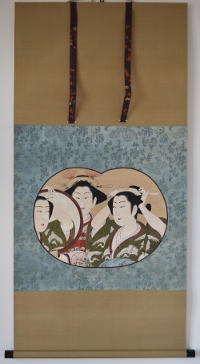
Click here to view image full size.
A rare, highly talented and enigmatic painter who produced only a few masterpieces. There is some confusion over his active working life with differing dates from 1748 to 1780, but he was certainly painting in the 1760s. This unusual composition shows a beauty adjusting her hair by obliquely looking in a mirror held by her maid who stares unnervingly straight at the viewer. This painting is well known and is illustrated in Nikuhitsu Ukiyoe, Collection of Ukiyo-e Paintings Classified by Artist and Schools, Vol. 4 (of 10): Katsukawa school, Suzuki Harunobu and Isoda Koryusai, pl. 83, edited and published by Shueisha, 1982. It is also mentioned on page 113 in Ukiyo-e Large Encyclopaedia, Vol. 2, edited by Japan Ukiyo-e Society, published by Taishukan, 1982. Another Kanshi painting showing a beauty collecting bamboo shoots in the snow was exhibited at the Metropolitan Museum of Art, NY, in 2014, in an exhibition: The Flowering of Edo Period Painting: Japanese Masterworks from the Feinberg Collection.
Full colour on paper with mica on the mirror, image size 14.5 x 20 in; 37 x 51 cms. In extremely good condition with double box. Painted c 1765.
Status: Sold
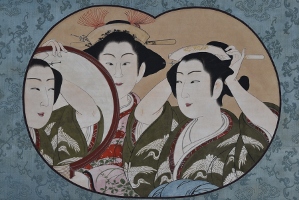
Click here to view image full size.
Kawamata TSUNEMASA (Fl. 1716-1751)

Click here to view image full size.
An original painting, sumi and full colour on paper, 27 x 10.5 in; 68.5 x 26.75 cms. Shows a parading courtesan with her kamuro. Tsunemasa’s small corpus of work shows him primarily painting portraits of beauties as well as mitate works alluding to classical themes. His delicate figures may have been an influence on Harunobu. Painted c 1745. In very good general condition. Signed Tsunamasa hitsu with Tsunemasa seal.
Status: Sold
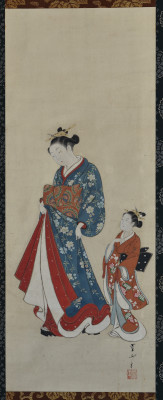
Click here to view image full size.
Utagawa HIROSHIGE (1797-1858)
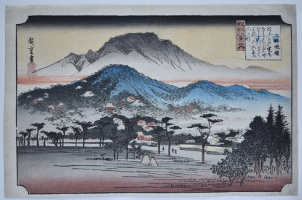
Click here to view image full size.
Mii no bansho, “Evening Bell at Miidera Temple” from a set Omi hakkei no uchi, “Eight Views in Omi [Province].” Shows the temple hidden amongst hills on the southern side of Lake Biwa. Miidera is the common name for the Onjoji, a temple of the Tendai sect founded in 858. Published by Hoeido and Eikyudo in c. 1834-5. The “Eight Views” theme was derived (as so much else in Japanese art) from China and based on the Eight Views of Xiaoxiang paintings of the 11th century. The subject was transposed to Omi and then taken up by such artists as Harunobu, and later Hiroshige. It was often playfully alluded to in sets of eight prints in mitate-e style.
Very good impression, colour and condition, Signed Hiroshige ga.
Status: Sold
Yashima GAKUTEI (1786-1868)
Click here to view image full size.
A surimono showing plum blossom and fugu (blowfish or puffer, Fugu pardalis). These fish are infamous for being poisonous, mainly from their liver and are expensive delicacies in the winter. Extremely rare: Two other genuine impressions are in the Museum of Fine Arts, Boston, acc. no. 21.9297 and illustrated in Coloured in the Year’s New Light, Japanese surimono from the Becker collection, Daniel McKee, 2008, Johnson Museum of Art, Cornell University, no. 15. There are also copies of this surimono which is how one will come across it. Poems above by Mahmansai Iedaru and Kanayaen Mahiro. Published c. late 1810s. Gakutei is best known for his surimono but he was also an accomplished painter and produced a fine set of landscape prints of views of Tempozan.
Fine impression and colour. One small repaired wormhole, otherwise very good condition. Signed Gakutei Harunobu.
Status: Sold
Yashima GAKUTEI (1786-1868)
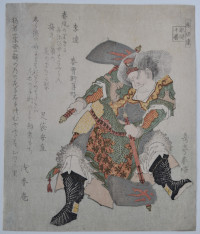
Click here to view image full size.
A surimono showing Li Kui (Jap: Ri Ki), one of the brigands from the One Hundred and Eight Heroes of the Popular Water Margin (the Suikoden). He was nicknamed the “Black Whirlwind” and is usually shown wielding two giant axes (as here). From a set Suiko Juban, “Ten Characters from the Water Margin.” Probably for the Kadonumaren Poetry Club c. late 1820s. Another two designs from the set are in the Harvard Art Museums, 1933.4.2003 and the Asian Art Museum, S.F., 2010.193. Rare: I cannot locate another impression at the moment.
Fine impression and colour. Slight soil and possibly slightly trimmed, otherwise very good condition. Extensive silver. Signed Gakutei Harunobu.
Status: Sold
Utagawa HIROSHIGE (1797-1858)
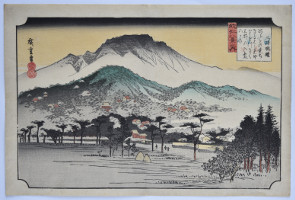
Click here to view image full size.
Mii no bansho, “Evening Bell at Miidera Temple” from an early set Omi hakkei no uchi, “Eight Views in Omi Province.” Shows the temple hidden amongst hills on the southern side of Lake Biwa. Miidera is the common name for the Onjoji, a temple of the Tendai sect, founded in 858. Published by Hoeido and Eikyudo in c. 1834-5. The “Eight Views” theme was derived (as so much else in Japanese art) from China and based on the Eight Views of Xiaoxiang paintings of the 11th century. The subject was transposed to Omi and then taken up by such artists as Harunobu , and later Hiroshige. It was also often playfully alluded to in sets of eight prints in mitate-e style.
Fine early impression and colour. Imperceptible centre fold, otherwise fine condition. Signed Hiroshige ga.
Status: Sold
A Twist of Figured Cloth – Shunga wood blocks
This is the first of an occasional blog that I hope clients will find interesting.
In the current update is an important and rare set of six original wood blocks for a shunga (erotic) book Aya no odamaki “A Twist of Figured Cloth” by Terasawa Masatsugu (active c1760-1790) published in 1776 in black and white, so these are the key-blocks (or sumi-blocks) which constitute reversed or mirror-images of the book.
It is pure serendipity that a few original blocks have survived. Many were planed down to recut as wood became more expensive during the 19th century and a lot more were probably used for kindling or destroyed by fire. There is also an apocryphal story that the Victoria and Albert Museum, here in London, burnt a large number of blocks after the Second World War to free up storage space. Early blocks, such as these, are particularly rare. Blocks that survive with big names attached – Harunobu or Hiroshige, for example, are invariably for copies. Shunga blocks are of added rarity. Indeed, this is the only set I have seen . The blocks have a great beauty in their own right and are from the wood of the single-petaled white mountain cherry (shiro-yamasakura or Prunus mutabilis).
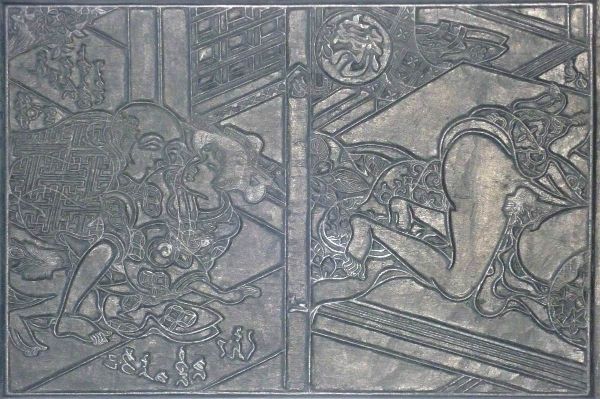
During the Edo period outlines were cut following the direction of the brush strokes of the original drawing, the knife being drawn towards the block-cutter. The block- cutter followed the drawing (hanshita-e) which was pasted face downward onto the block and partially peeled or rubbed with hempseed oil to render it more visible. Cutting was deeper in the 18th century and became shallower during the 19th, probably due to the cost of wood and the gradual sophistication of the cutters. In Japan wood was cut with the grain; this method is fundamentally similar to western chiaroscuro woodcuts, hence the operation is one of relief printing as opposed to intaglio. The impression from the grain of the wood-block was transferred to the paper during printing and is visible on early impressions – an infallible way of recognising genuine impressions rather than copies.
Colour prints used proofs from the key-block to make the colour blocks and were keyed by the simple expedient of marks (notches) cut in the block on the upper and lower left corners. Cutting of a set of blocks could take two or three days while complicated sets were finished within twenty days.
The blocks are priced separately to give as many collectors as possible the opportunity to acquire one, and would sit well with any serious collection of prints, books or shunga.
Yashima GAKUTEI ( 1786-1864 )
Click here to view image full size.
A surimono showing the Chinese warrior Huang Zhong ( Jap: Ko Chu, d. 220 AD ). Best known for his role in the novel Tale of the Three Kingdoms. He is shown wearing tiger skin breeches and armed with a large sword, bow and arrows. From a set Go koshogun, “The Five Tiger Generals.” Title on right Sono yon Ko Chu, “Nr 4 Huang Zhong. “ Issued by the Asakusagawa Poetry Club ( seal top left ) for the Tiger year 1818. Two poems by Shinsokutei Kashimaru ( right ) and Hogetsudo Yukitake ( left ).
Fine impression. Very good colour with extensive gold and silver. Very good condition. Signed Gakutei Harunobu.
Status: Sold
Yashima GAKUTEI ( 1786-1864 )
Click here to view image full size.
A surimono showing the Chinese warrior Ma Chao ( Jap: Ba Cho, 176-222 AD ). Best known for his role in the novel Tale of the Three Kingdoms. He is shown leaning on a giant axe. From a set Go koshogun, “The Five Tiger Generals.” Title on right Sono go Ba Cho, “Nr 5 Ma Chao. “ Issued by the Asakusagawa Poetry Club ( seal top left ) for the Tiger year 1818. Two poems by Ki no Yoshito ( right ) and Sengetsudo ( left ).
Fine impression. Very good colour with extensive gold and silver. Very good condition. Signed Gakutei Harunobu.
Status: Sold
Yashima GAKUTEI ( 1790-1869 )
Click here to view image full size.
A rare chuban yoko-e surimono from a series Kinki shoga or the Four Accomplishments. These pursuits were popular amongst Chinese and Japanese literati: Playing a musical instrument; playing go; calligraphy, and ( as here ) painting. The composition shows a Heian courtier and two court ladies admiring a painting. A poem by Mado no Muratake ( whose pupils probably commissioned this set ) gives his age as 74, and since he died in 1824 at 82, the surimono must have been issued in 1816.
Fine impression and colour. Minimal edge soil, otherwise fine condition. Signed Gakutei Harunobu.
Status: Sold
Katsukawa SHUNSHO (1726-1792)
Click here to view image full size.
An exceptional hosoban showing the actor Nakamura Tomijuro I in the role of a courtesan. Published c. 1771 and the influence of Harunobu can be seen. Probably the centre panel of a triptych.
Superb impression on thick hosho with the outlines of the figure in relief, similar to the best Harunobu prints of a few years earlier. Very fine unfaded colour. Fine condition. Signed Miyagawa Shunsho. (A signature I have not seen before: He did study under Miyagawa Shunsui early on.)
Status: Sold
Kakemono-e ISHIZURI-E (c. late 18th century)
Click here to view image full size.
A falcon perched on a tree trunk above flowering camellias and a stream. These kakemono-e lie somewhere between prints and paintings. The actual technique employed seems to have involved pressing dampened paper into engraved wood. The pigment is then applied to the raised areas; the print then being laid onto thicker paper and pressed home giving a crinckley surface. They have traditionally been ascribed to Koryusai although examples are known with other signatures. Another example of this design was in the Vever collection, Sothebys, Part 1, 26/3/1974, no. 88, p. 69 where Jack Hillier states: ?The kakemono-e are however extraordinary technical and artistic creations, and the present specimen is one of the finest of the designs, comparable to the famous ?White Falcon? in the AIC ( Harunobu, etc., No. 181, p. 271 ).? ( That example appears to have been badly cut at the bottom. ) 35.5 x 11.5 inches, 90 x 29 cms. Mounted as a painting with rollers and box. Excessively rare.
Status: Sold
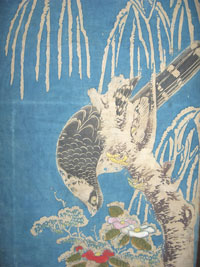
Click here to view image full size.
Torii KIYOMITSU (1735-1785)
Click here to view image full size.
A large oban panel, 11.75 x 16.5 in; 29.75 x 42 cms showing three beauties playing, from the left, a shamisen, a koto, and a kokyu in an interior with hand-painted screens. A beautiful and important print. Kiyomitsu was the son and pupil of Kiyonobu II, the third of the Torii line and a prominent print designer. He pioneered the polychrome print which was brought to full fruition by Harunobu. Benizuri-e with beni, blue, yellow and green by superimposing blocks. Published by Kichi Uemura (Kichiemon of Emi-ya) c. 1764. There was a convention of printing three hosoban designs to a sheet from the 1720s to 1760s with a linking theme, in this case even though the image is signed three times it is as one. Exceptionally rare: The only other impression appears to be that in the Ritsumeikan University, Japan, Z 0165-424. An unread collector’s seal bottom right.
Fine impression and colour. Minor expertly restored areas, but in fine condition for a print of this size and date. Signed three times Torii Kiyomitsu ga.
Status: Sold
Torii KIYOMASU I (Active c1700-1722)
Click here to view image full size.
The actor Nakamura Takesaburo playing a female itinerant tea vendor. A pair of panniers is slung across his shoulders holding the paraphernalia for tea making including, in the lower sections, a brazier and water jug. Published c1716-20 by Sagamiya. Published in Yamaguchi and Asano ( 1982 ), Moronobu – Harunobu, vol.6 of the Complete Dictionary of Ukiyo-e, Tokyo, Shogakukan, pl.86, p.46. Probably the only known impression extant.
Very good impression with fine contemporary hand-colouring. Expertly restored corners and areas at left and bottom edges. One repaired wormhole beside the hand holding the bamboo rod. Signed Torii Kiyomasu hitsu.
Status: Sold
Katsushika HOKUSAI (1760 – 1849)
Click here to view image full size.
An exceptionally rare and very unusual koban surimono showing two onnagata actors. The only other recorded impression seems to be in Hokusai, Gian Carlo Calza, Electa, 1999, plate III.57. That has the months on the title slip of book for 1803 (and a poem top left). So this is an egoyomi and my impression must be either a proof or the first issue (same as Harunobu prints issued first without date, then with).
Very fine impression and colour. Signed Gakyojin Hokusai ga.
Status: Sold
